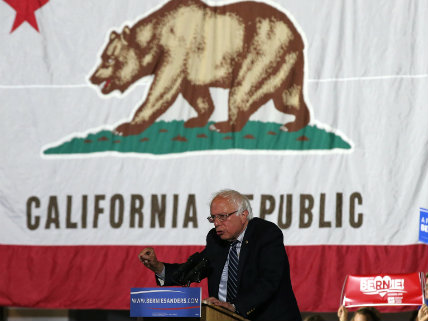California's Single-Payer Health Care Plan Would Cost More Than the State's Whole Budget
Like in Colorado, New York, and Vermont, California is learning that a single-payer plan would be prohibitively expensive.

Stop me if you've heard this one before. A state considers implementing a single-payer health care system, then learns it would have to use its entire annual budget, plus some, to fund the idea.
The latest stop on this magical mystery tour of progressive health care plans is California, where U.S. Sen. Bernie Sanders (I-Vermont) has been campaigning on behalf of a proposed state-run single-payer system. On Monday, state lawmakers in Sacramento got their first look at the price tag for the proposal, which rings in at a whopping $400 billion annually.
The Sacramento Bee notes that, even after accounting for an estimated $200 billion that could be saved by replacing current state-run health programs with the single-payer program, the state would still need to come up with $200 billion annually.
This year's state budget in California, by the way, is about $180 billion. That means that implementing a single-payer health care system would require doubling (at least) the state's current tax burden. The analysis of the health care proposal presented to lawmakers on Monday suggests a 15 percent increase to the state's payroll tax to provide the necessary revenue.
The cost analysis is seen as "the biggest hurdle to creating a universal system," the Bee reports.
If this sounds familiar, that's because it is. Just last week, we reported on a similar single-payer proposal in New York State, which would require doubling (and possibly quadrupling, depending on which projection you believe) the state's tax burden. Vermont's attempt to implement a single-payer health care system collapsed in 2014 because the costs were too high. Colorado voters rejected a proposed single-payer system in 2016 when faced with the prospect of increasing payroll taxes by 10 percent to meet the estimated $25 billion annual price tag.
The list of states that have tried to go single-payer is still a small sample size, but a fairly wide ranging one. It includes states with large populations and small ones. States with a variety of economies and tax systems. States that are growing quickly and those that aren't.
Despite that range of variables, one thing remains constant: state-level single-payer health plans would require massive increases in tax revenue, equal or larger than the amount of revenue consumed by every other state-level program in a single year.
California's proposal is particularly expensive because it's not just a single-payer proposal, but a generous one. As Vox details, "the state would pay for almost all of its residents' medical expenses—inpatient, outpatient, emergency services, dental, vision, mental health, and nursing home care—and Californians would not have any premiums, copays, or deductibles." Undocumented immigrants would be covered too.
Even in the state that spends the most money each year, the $200 billion increase is asking for a lot. Californians pay an average of 11 percent of their income in state and local taxes, the sixth highest of any state, according to the Tax Foundation, a Washington, D.C.,-based think tank that favors lower tax rates, and the state's top income tax rate of 13.3 percent is already the nation's highest.
"Needless to say, doubling California's tax burden would give them the highest taxes in the country by far," Joe Henchman, vice president of state projects for the Tax Foundation, told Reason on Tuesday.
The proposal "will cost employers and taxpayers billions of dollars and result in significant loss of jobs in the state," warns the California Chamber of Commerce.
A single-payer system at the federal level would have the same fiscal problems, of course, but unlike state governments that are required to balance their budgets annually, a nationally single-payer system would just be added to the federal government's ever-growing tab. That's not necessarily better, but it would offer something of a solution to the problem of how to pay for a hugely expensive new entitlement. Until Democrats control the federal government, though, state-level efforts like the ones in New York and California are likely to continue percolating.
There's one other thing that's fairly consistent among the states that have proposed single-payer systems in recent years: When voters find out how much a single-payer system will cost, they are much less likely to support one.
Single-payer advocates learned that lesson last year in Colorado at the ballot box, as the state turned blue for Hillary Clinton even as 79 percent of voters said "no" to single-payer health care.
Other polling bears out that relationship. A recent poll commissioned by the California Association of Health Underwriters, found that 66 percent of California residents are opposed to single-payer health care. Opposition increased to 75 percent when those polled were told the price tag for the system is $179 billion annually—which is actually lower than what the legislative analysis suggests.
There's also this analysis from the Kaiser Family Foundation, which shows how support for single-payer health care declines when there is a price tag attached to the idea.

When free health care provided by the state government isn't free, it's a much more difficult sell. Progressives in California have their work cut out for them.


Show Comments (162)